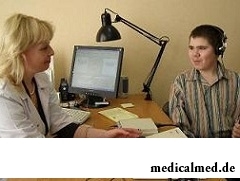





Relative deafness

Short characteristic of a disease
Relative deafness is a disease which is characterized by a hearing impairment owing to what perception of informal conversation becomes difficult. Often relative deafness is shown at children's age. From inborn relative deafness one newborn for 1000 suffers. Generally, from 2 to 3% of the population of the earth have this problem.
Relative deafness reasons
Inflammatory diseases of a middle ear are the main reason for relative deafness at children (generally acute and chronic otitis). The hearing impairment arises owing to hems, perforations and unions in a tympanic membrane. Infectious diseases, such as flu, measles, can lead to pathological changes in an inner ear and in an acoustical nerve that involves sharp decrease in hearing. Sometimes relative deafness happens inborn. Such decrease in hearing can negatively influence speech development of the child.
At adults relative deafness arises owing to an otosclerosis, after use of some drugs, because of noise and vibration on production, at poisonings with industrial or household poisons. Also decrease in hearing can develop against the background of atherosclerosis as at this disease blood supply of an inner ear is broken. There is such concept as senile relative deafness when the hearing impairment is caused by age changes in an inner ear and acoustical nerves.
Relative deafness degrees
Distinguish three degrees of relative deafness.
At easy relative deafness (the first degree) the patient distinguishes a conversation in a whisper at distance from 1 to 3 meters, and informal conversation at distance more than 4 meters. The patient cannot adequately perceive a conversation at extraneous noises or distortion of the speech.
Relative deafness 2 degrees (average relative deafness) takes place if the patient perceives the shepotny speech at distance less, than one meter, and informal conversation hears at distance from 2 to 4 meters. Relative deafness 2 degrees is characterized by illegibility in perception of all words in a normal situation, numerous repetitions of some phrases or separate words are required.
Heavy relative deafness (the 3rd degree) is shown in impossibility to distinguish whisper even in very short distance, informal conversation the patient hears less than 2 meters at distance. This degree of relative deafness assumes existence of certain difficulties in communication. The patient should resort to the help of the hearing aid to have an opportunity normally to communicate with others.
Types of relative deafness
Distinguish neurosensory relative deafness and conductive relative deafness.
Conductive relative deafness develops owing to average otitis, adenoides, an otosclerosis, pathological change and dysfunction of an Eustachian tube. This type of decrease in hearing is characterized by changes in a tympanic membrane and acoustical stones.
Neurosensory relative deafness - develops owing to damage of nervous cells to an inner ear, an acoustical nerve and the center of acoustical system. Infectious diseases, a stress, injuries of an inner ear, vascular frustration (atherosclerosis, a hypertension), negative action of some drugs and chemicals can be the reasons of neurosensory relative deafness. The main symptoms of neurosensory relative deafness is the hearing impairment in combination with a sonitus, a headache. Vomiting or nausea can sometimes be observed.

Relative deafness diagnosis
For diagnosis use a speech audiometriya which consists in recognition by the patient of shepotny and informal conversation. On the basis of this method of a research it is possible to establish relative deafness degree.
It is possible to define existence and degree of relative deafness by a tone audiometriya more precisely – check of hearing on tones of speech range. Diagnosis of relative deafness by means of tuning forks is also possible. Especially their use is justified in need of diagnosis at home though this method is used also in policlinics.
Relative deafness at children
Major factors which can provoke emergence of relative deafness in children are infectious or viral diseases of mother during pregnancy when there is a formation of acoustic organs. Also to development of a disease can give infectious diseases of the child in early age. Plays a role and a hereditary factor.
About 50% of children at whom parents have this disease have inborn relative deafness. Causes of illness children can have birth trauma, prematurity, asphyxia of the newborn, severe toxicosis during pregnancy, intoxication alcohol or other harmful substances during pregnancy.
Diagnosis of a disease at early age is difficult as the child cannot tell about the acoustical feelings. Therefore for check of hearing at children use the special device. It makes sounds of a certain frequency, at the same time reaction of the child is fixed. And parents can, watching the child, to estimate his acoustical abilities. For this purpose it is necessary to know the main norms of development of children. At monthly age the baby shudders or fades at loud sounds, in four months turns the head aside from where the sound is heard, there are festivities which turn into babble, aged from 8 up to 10 months begin to say new sounds. If on any of stages of development of the child of his action do not meet standard, it is necessary to show the child to the doctor for hearing check.
Relative deafness treatment

Treatment of relative deafness depends on a type of a disease.
At conductive relative deafness the only method of treatment is an operative measure. At contraindications to carrying out operation hearing aid is possible.
Neurosensory relative deafness will respond to conservative treatment. Use medical supplies which improve blood supply in an inner ear (piracetam, Cerebrolysinum, etc.). Treatment of relative deafness assumes administration of drugs, saving from dizziness (бетагистин). Also use physical therapy and reflexotherapy. At chronic neurosensory relative deafness use hearing aid.
Each person has not only unique fingerprints, but also language.

Separate food - the system of meal based on digestion physiology which is carried to improvement methods. In opinion д...
Section: Articles about health
Women quite often suffer from complexes concerning the sizes of the bust. Strangely enough, not too modest, and excessively curvy shapes become the reason of sincere discomfort sometimes. Except psychological problems, a big bust sometimes with...
Section: Articles about health
The saying "the rich do not know how the other half lives" is known to all. In a broad sense it is that we can not always understand the person whose features of a state are unknown to us. If with physiological characters of diseases the situation is more or less clearly (having noticed them, we realize that to the person nezdorovitsya), then with symptoms of the illnesses affecting the mental sphere everything is much more difficult. Not absolutely usual behavior is quite often perceived surrounding as a ridiculous eccentricity, or that much ху...
Section: Articles about health
The concept "gluten" (differently, a gluten) combines group of the proteins which are a part of rye, barley and wheat. For most of people упот...
Section: Articles about health
Smack in a mouth can arise in the natural way – as a result of lack of morning hygiene or reception of the corresponding food. However in certain cases its existence is a sign of certain pathologies, and allows to reveal an illness at an early stage. In we depend...
Section: Articles about health
At this plant there are a lot of names: tuberiferous sunflower, Jerusalem artichoke, solar root, earth pear. Contrary to popular belief, it is not an exotic plant at all. The wild girasol grows in a midland of Russia practically everywhere: at the edges of roads, to slopes of ravines, on heathlands. Also several cultural versions different from wild plants are removed by larger and juicy root crops....
Section: Articles about health
Each person knows that fervescence is an illness sign. However about existence of diseases can to suite...
Section: Articles about health
Coffee - the tonic loved by many for the invigorating aroma and deep taste. Having the stimulating effect, coffee increases working capacity, promotes concentration of attention, fights against drowsiness and improves mood. Statistically, about 30% of inhabitants...
Section: Articles about health
Wood louse – the ordinary-looking unpretentious plant extended in all territory of our country. It quickly expands, and sometimes fills sites, bringing a lot of chagrin to gardeners. Perhaps, they would be upset less if knew that the wood louse is valuable medicinal raw materials. A, C and E vitamins, organic acids, tannins, wax, saponins, lipids, mineral salts and essential oils are its part....
Section: Articles about health
Not without reason doctors say that 90% of diseases begin or develop because of misoperation of intestines. Disturbance of its functions связ...
Section: Articles about health
For anybody not a secret that our country is one of the most "drinking" in the world. At clear understanding that the use of hard alcoholic drinks – occupation extremely harmful, most of Russians belong to alcoholism with unjustified loyalty. These...
Section: Articles about health
Eyes – unique body on the structure thanks to which the person obtains about 80% of information on the world around: about a form, color, size, the movement, and also many other parameters of objects or phenomena. But whether much we know about the most valuable sense body which, according to the scientist Sechenov, provides us about one thousand various feelings a minute? Let's consider 10 most surprising facts about eyes and sight....
Section: Articles about health
Statistically, in Russia about 34% of citizens smoke. Most of consumers of tobacco has problems about health sooner or later...
Section: Articles about health
Within several decades of our compatriots convinced that the use of butter nasty affects a condition of coronary vessels. As a result the reputation of a product was impaired thoroughly a little, and many almost ceased to include...
Section: Articles about health
Obesity is called a disease of 21 centuries, for the last 100 years the number of the people suffering from excess body weight considerably increased. Statistically, on Earth already about 1,5 billion corpulent people, and 500 million from them have the extreme degree of completeness negatively affecting quality and duration of their life. What served as the reason of growth of stout persons on the planet? How not to get to their ranks? Let's consider five main premises for increase in body weight in conditions современнос...
Section: Articles about health
The sclera and mucous membrane of an eye are intensively supplied with blood vessels which problem - to sate nervous tissues of body to a pitata...
Section: Articles about health
Venereal diseases in medicine are called the infections which are transmitted preferential sexually, now they and are called - infections, sexually transmitted, or STD. Among them is also life-threatening. In spite of the fact that majority...
Section: Articles about health
The popular expression "run from a heart attack" became the motto of the people supporting active lifestyle. Moreover, run became a peculiar fashionable tendency: sales of racetracks and the accompanying goods for run are at permanently high level. Whether really it is possible for one and all people and it is necessary to run to receive the portion of health, a charge of cheerfulness and good mood?...
Section: Articles about health
What is in our understanding weeds? It plants which are considered to be suitable only for compost pits and feeding жи...
Section: Articles about health
Almost each of us during life faced dissatisfaction with own body. At such moments, as a rule, we begin to shame ourselves, urgently we go on the most rigid diet promising minus of 10 kg in a week, or we exhaust ourselves in the gym to полусм...
Section: Articles about health
One of the major chemical processes happening in a human body are oxidation reactions. They go with participation of fats and carbohydrates which we receive from food, and the oxygen getting to us from air. A main goal of such reactions is obtaining the energy necessary for life activity. Unfortunately, as a result of these processes dangerous by-products – so-called free radicals are allocated. To minimize harm which they can cause to the person neo...
Section: Articles about health
The words "disease" and "patient" not without reason come from one root – "pain". As a rule, symptoms of illnesses thoroughly spoil the patient...
Section: Articles about health
Household skills which to us so diligently imparted in the childhood it appears, not always bring only benefit. According to results of the last researches, some habits which for a long time were considered useful and even necessary can become...
Section: Articles about health
According to data of World Health Organization, the cataract is diagnosed almost for 7% of the population of Earth. The statistics of incidence is considered not full as at an initial stage the illness, as a rule, does not cause to the person of special inconveniences, and many diseased sees doctors not at once. The cataract is not only one of the most widespread ophthalmologic illnesses, but also the reason of a half of cases of loss of sight....
Section: Articles about health
Herpes simplex of the first type (the infectious disease which is shown periodic bubble rashes on is called...
Section: Articles about health
Water with a lemon - idle time in preparation drink which supporters of a healthy lifestyle already managed to appreciate. Used in a warm look and on an empty stomach, it is one of the most useful prophylactics allowing to prevent tens з...
Section: Articles about health
The main role in development of a peptic ulcer of a stomach and duodenum the bacterium Helikobakter plays pilor. Activity and the strengthened reproduction of this microorganism lead to weakening of protection of mucous membranes and their erosive damage. Displays of an illness seriously reduce quality of life: patients regularly test attacks of severe pain, heartburn, nausea. On this background also psychoemotional malfunctions develop: a kidney-vetch, as a rule, shows an acrimony, ча...
Section: Articles about health
